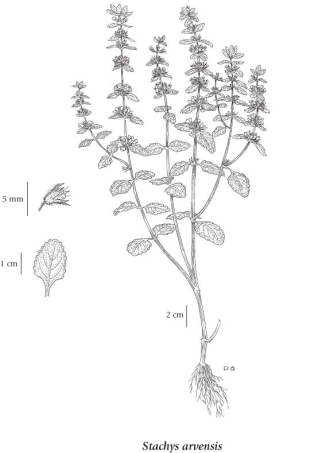field hedge-nettle (staggerweed)
Lamiaceae (Mint family)
Introduction to Vascular Plants
Species Information
General:
Annual herb from a taproot; stems ascending to erect, 10-30 cm tall, branched, stiff-hairy, 4-angled.
Leaves:
Opposite, egg-shaped, 1.5-2.5 cm long, tips blunt, bases rounded to slightly notched, margins toothed; stalks 1-2.5 cm long.
Flowers:
Inflorescence of 2- to 6-flowered clusters in the axils of leaf-like bracts (becoming smaller and unstalked above) forming a lax, interrupted, terminal spike; corollas pale purple, 6-7 mm long, tube 3-6 mm long, with a ring of hairs within; calyces tubular-bell-shaped, hairy, tube 2.5-4 mm long, upper part purple, teeth triangular egg-shaped to lanceolate.
Fruits:
Nutlets, 4 clustered together, egg-shaped, rounded at tip.
Illustration

If more than one illustration is available for a species (e.g., separate illustrations were provided for two subspecies) then links to the separate images will be provided below. Note that individual subspecies or varietal illustrations are not always available.
Illustration Source: The Illustrated Flora of British Columbia
Ecology
The table below shows the species-specific information calculated from
original data (BEC database) provided by the BC Ministry of Forests and Range.
(Updated August, 2013)
| Site Information |
Value / Class |
||
|
Avg |
Min |
Max |
|
| Elevation
(metres) |
1125 | 956 | 1295 |
| Slope
Gradient (%) |
11 | 0 | 23 |
|
Aspect (degrees) |
49 | 50 | 50 |
| Soil
Moisture Regime (SMR) [0 - very xeric; 4 - mesic; 8 - hydric] |
4 | 3 | 5 |
| Modal
Nutrient Regime
Class |
C | ||
| #
of field plots species was recorded in: |
2 | ||
| Modal
BEC Zone Class |
IDF | ||
|
All BEC Zones (# of stations/zone) species was recorded in |
ICH(1), IDF(1) | ||
|
Source:
Klinkenberg 2013
|
|||
Habitat and Range
Waste places and cultivated areas in the lowland zone; rare in SW BC, known only from Vancouver and Victoria; introduced from Europe.Status Information
Taxonomic Keys
KEY TO STACHYS
1. Plants annuals......................................................................S. arvensis 1. Plants perennials. 2. Plants densely covered with soft, white hairs...........................S. byzantina 2. Plants not white-hairy. 3. Leaves unstalked, at least those of upper half of stem.............. S. palustris 3. Leaves all stalked. 4. Plants 70-150 cm tall; corollas deep red-purple; tubes 15-23 mm long.......................S. chamissonis 4. Plants 30-80 cm tall; corollas pale pink to pink-purple, tubes 8-13 mm long....................S. mexicana Source: Illustrated Flora of British Columbia |
